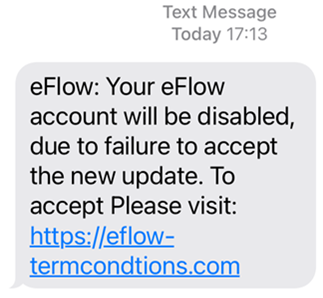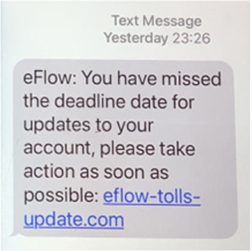Public urged to ‘stop, think and check’ as onslaught from fraudsters set to widen.
Fraudsters are still circulating a high volume of fraudulent eFlow text messages, Bank of Ireland has warned.
In a wave that has lasted since February – with 10 fake eFlow sites set up in one single day – the bank has warned of an increase in fraudulent messages that will clone more Irish brands in the months ahead.
“Based on intelligence we have received, we are also expecting fraudsters to ramp up activity cloning other well-known Irish brands in the coming months, particularly electricity and gas companies”
Fraudsters pretending to be the motorway operator eFlow are sending messages urging customers to pay outstanding toll charges or update account details.
Be wary
The bank warned that the website links in these messages are not genuine and are an attempt to collect personal card and online banking details. Consumers are reporting a consistently high volume of these text messages, and Bank of Ireland is warning customers to be extremely wary.
“Smishing attacks tend to come in waves, and previously we have seen fraudulent messages appearing to be from delivery services, utility companies, Government agencies or banks. But this latest attack, with fraudsters sending messages purporting to come from eFlow, has lasted now for several months, which is unusual,” said Nicola Sadlier, head of Fraud at Bank of Ireland.
“Based on intelligence we have received, we are also expecting fraudsters to ramp up activity cloning other well-known Irish brands in the coming months, particularly electricity and gas companies.
“When you click on the eFlow text message it leads to a fake website where some will end up providing their confidential card and bank account details. The numbers of fake eFlow websites has been steadily increasing – we’re seeing anything up to 10 sites being set up by fraudsters in a day. If people recently passed through a toll, they might be more inclined to click on the text message thinking it is legitimate.
“eFlow has advised that they do not send text messages with links to confirm account or payment details. Text messages purporting to be from any company should be treated with extreme caution – the general rule is to stop, think and check.”
Examples of fraudulent messages
Avoid being smished
Bank of Ireland’s advice to customers in response to the current smishing scam:
- Do not click on links or respond to SMS text messages which appear as if sent by a motorway toll operator looking for payment for an unpaid toll;
- Remember that companies such as these, or banks, delivery companies, utility providers and Government agencies will never send a text linking to a website that requests online banking details;
- eFlow has advised that they do not send text messages with links to confirm account or payment details.
- Verify the identity of the sender. Call the company using their legitimate phone number (ensure you source it independently of any SMS);
- If you get a suspicious text, please email a screenshot of the text to 365Security@boi.comand then delete the text; and
- Bank of Ireland customers who think they gave away their banking details should call our 24/7 Freephone line 1800 946 764







